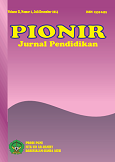PENERAPAN MODEL 3 CM LEARNING BERBANTUAN MEDIA KONKRET UNTUK MENINGKATKAN KETERAMPILAN BERPIKIR KRITIS DAN HASIL BELAJAR MATEMATIKA
DOI:
https://doi.org/10.22373/pjp.v12i3.21368Keywords:
3 CM Learning, critical thinking skills, Learning Outcomes, MathematicsAbstract
Conditions at SD N 02 Bringin show low critical thinking skills which have an impact on low student learning outcomes in grade 5 mathematics learning. This is due to the lack of teacher variation in using appropriate learning models so that learning is less attractive to students' curiosity. Based on these conditions, researchers conducted research that aimed to describe the syntax of the 3 CM learning model Learning and with this model it can improve critical thinking skills and mathematics learning outcomes of 5th grade students of SD N Bringin 02. The results showed that critical thinking skills in action I got an average of 76% with the critical category, in action II the average critical thinking skills increased to 88% with very critical category. For learning outcomes in action I as many as 11 students with a percentage of 46% have received a complete score, and as many as 13 students with a percentage of 54% have not completed. In action II there was an increase, 21 students with a percentage of 87% were declared complete and the remaining 3 students with a percentage of 13% were declared incomplete. Based on the results of research conducted at SD Negeri Bringin 02 for grade 5 by applying the 3 CM model Learning assisted by concrete media, especially in mathematics, is proven to be able to improve critical thinking skills and student learning outcomesReferences
DAFTAR PUSTAKA
Abdillah, L. (2020). Bahan dan metode Artikel Ilmia . binadarma, 77-78.
Abdillah, L. A., Fauziah, A., Napitupulu, D. S., Sulistiyo, H., Fitriyani, Sakti, B. P., . . . Nurkanti, M. (2021). Penelitian Tindakan Kelas Teori dan Penerapannya. Indramayu: penerbit Adab.
Alsaleh, N. J. (2020). Teaching Critical Thinking Skills: Literature Review. TOJET: The Turkish Online Journal of Educational Technology, 21.
Andriani, R., & Rasto. (2019). Motivasi Belajar Sebagai Determinan Hasil Belajar Siswa. Jurnal Pendidikan Manajemen Perkantoran, 80-86.
Ayu Chinintya Lestari, & Annizar, A. M. (2020). Proses Berpikir Kritis Siswa dalam Menyelesaikan Masalah PISA. Jurnal Kiprah, 46.
Khairunnisa, G. F., & Ilmi, Y. I. (2020). edia Pembelajaran Matematika Konkret Versus Digital:Systematic Literature Reviewdi Era Revolusi Industri 4.0. Jurnal Tadris Matematika, 131-140.
Kusumaningrum, R. S., & Nuriadin, I. (2022). Pengaruh Pendekatan Matematika Realistik Berbantu Media Konkret terhadap Kemampuan Representasi Matematika Siswa. Jurnal Basicedu, 6613-6619.
Larasati, R., & Prihatnani, E. (2021). Pembelajaran Daring dengan Model Kolaboratif 3 CM dan Tutor Sebaya untuk Meningkatkan Hasil Belajar dan Kreatifitas. e-journal UKSW, 271-282.
Mizaniya. (2020). Analisis Materi Pokok Matematika MI/SD . Jurnal Pendidikan Dasar Islam, 98-110.
Munandar, A. (2020). Sisitem Student Center Learning dan Teacher Center Learning. Bandung: Media Sains Indonesia .
Rizti, T. M., & Prihatnani, E. (2021). Efektivitas Model Pembelajaran 3CM (Cool-CriticalCreative-Meaningfull) terhadap Kemampuan Berpikir Kritis Siswi SMP. Mosharafa:Jurnal pendidikan Matematika, 213-224.
Ruqoyyah, S., Murni, S., & Wijaya, T. T. (2020). The Effect of VBA for Microsoft Excel as Teaching Material to Improve. Mimbar Sekolah , 251-268.
Setiawan, Y. (2020). 12Pengembangan Model Pembelajaran Matematika SD Berbasis Permainan Tradisional Indonesia danPendekatan Matematika Realistik. Scholaria: Jurnal Pendidikan Dan Kebudayaan, 12-21.
Sholehah, S. H., Handayani, D. E., & Prasetyo, S. A. (2018). Minat Belajar Siswa Pada Mata Pelajaran Matematika. Jurnal Mimbar Ilmu, 237.
Sidabutar, R. (2018). Hasil Belajar Matematika Siswa Ditinjau dari Kebiasaan Belajar dan. Jurnal Pendidikan, 98-100.
Suyetni, S. (2021). Impplementasi Konsep Pembelajaran Model RANI Terhadap Penguasaan Materi Matematika Di SDN 2 Jelapat Kecamatan Dusun Selatan Tahun Pelajaran 2018/2019. Jurnal Mitra Pendidikan(JMP Online), 560-570.
Syachtiyani, W. R., & Trisnawati, N. (2021). Analisis Motivasi Belajar Dan Hasil Belajar Siswa Di Masa Pandemi Covid-19. Prima Magister: Jurnal Ilmiah Kependidikan, 90-101.
Wahyudi, Nuryani, Setiawa, D., & Yohana. (2022). Pengembangan Media Smart Land Untuk Meningkatkan. Jurnal Pendidikan dan Kebudayaan SCHOLARIA, 21.
Widana, I. W., Parwata, I. M., Parmithi, N. N., Jayantika, I. G., Sukendra, K., & Sumandya, I. W. (2018). Higher Order Thinking Skills Assessment towards Critical Thinking on Mathematics Lesson. International Journal of Social Sciences and Humanities, 24-23.
Wildaniati, Y. (2019). Penggunaan Alat Peraga untuk Meningkatkan Hasil Belajar Siswa Kelas V SD N 2 Gunung Katun Kecamatan Baradatu. Jurnal Dewantara, 56-72.
Zubaidah, S. (2018). Mengenal 4C: Learning and Inovation Skills Untuk Menghadapi Era Revolusi Industri 4.0. 2nd Science Education National Converence , 1-18.
Downloads
Published
Issue
Section
License
- Authors retain copyright and grant the journal right of first publication with the work simultaneously licensed under a Creative Commons Attribution License that allows others to share the work with an acknowledgment of the work's authorship and initial publication in this journal.
- Authors are able to enter into separate, additional contractual arrangements for the non-exclusive distribution of the journal's published version of the work (e.g., post it to an institutional repository or publish it in a book), with an acknowledgment of its initial publication in this journal.
- Authors are permitted and encouraged to post their work online (e.g., in institutional repositories or on their website) prior to and during the submission process, as it can lead to productive exchanges, as well as earlier and greater citation of published work (See The Effect of Open Access).

